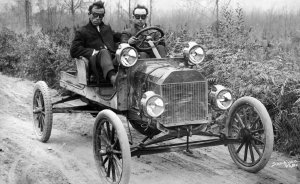An Extreme Case of Boosterism
A footrace to the summit of Mount Baker was a promotional scheme championed by the Mount Baker Club – a local booster organization composed of Bellingham businessmen – with the aim of attracting national attention and increasing tourism to the region. In partnership with the Bellingham Chamber of Commerce, they staged the first Mount Baker Marathon in 1911.
The marathon would begin in downtown Bellingham at the Chamber of Commerce. From there, racers had the choice of taking a train 44 miles to the town of Glacier and running 14 miles to the summit via the steep Glacier Trail; or driving by car 26 miles to Heisler's Ranch east of Deming and running 16 miles to the summit via the more gradual Middle Fork route. The racers were then to retrace their steps back to Bellingham. The race was not only a test of endurance, but a competition between rival technologies and communities.
The First Marathon
At 10 p.m. on August 10, 1911, a field of 14 racers set off; six in automobiles and eight by train. The late start was a safety measure intended to provide the racers with hard snow on the mountain. The autos arrived at their destination first. Both sets of racers had to achieve an elevation gain of roughly 9,700 feet, but those arriving by train faced a 28-mile roundtrip run, while those arriving by automobile had 32 miles ahead of them.
Each racer carried a certificate and was required to obtain judges' signatures at the summit and at the finish line. Monitors were also stationed along the trails to keep the competition sportsmanlike. Only six runners emerged from timberline and set off across the glaciers of Mount Baker. N.B. Randall was the first to reach the summit; the second was Harvey Haggard. Both had taken the Glacier route. Joe Galbraith was the first to reach the summit out of those who took the Deming Trail. Five racers reached the summit before the judges closed their station due to wind and cold.
Harvey Haggard beat Randall back to the train and departed for Bellingham, leaving Randall behind. En route, however, the train encountered a bull on the railroad tracks and derailed while Haggard was between changes of clothing. Clad in a robe, Haggard hitched a ride in a buggy, transferred to horseback, and then was picked up by a passing automobile after he was thrown by the horse.
Haggard crossed the finish line in Bellingham 13 hours after he started–32 minutes behind Joe Galbraith who had a much less eventful return trip. Joe Galbraith was declared the winner of the first Mount Baker Marathon and collected the official $100 purse. However, an appreciative crowd raised $50 for Haggard; the chamber contributed another $30; and the towns of Glacier and Maple Falls honored the racer for his pluck with $100.
Subsequent Races
The success of the first Mount Baker Marathon prompted the organizers to dream of an even more ambitious event the following year. For 1912, the purse was increased to $500 and prizes awarded through fourth place in hopes of drawing an international field of competitors. The design of the race itself was altered slightly for the safety of the racers and to keep the public better apprised of their progress. A concurrent three-day festival was planned that included a circus; hot air balloon rides; parachute jumps; war canoe races; and a visit by three U.S. Navy ships. The ensuing festivities in July drew an estimated 15,000 to 60,000 spectators.
Unfortunately, inclement weather at the summit of Mount Baker delayed the marathon's start. Originally scheduled to begin on July 24, the race didn't occur until July 31, and as a result, the field was reduced to nine racers. Harvey Haggard won the second Mount Baker Marathon via the train and Glacier Trail without major incident.
For the third – and what would prove to be the last – Mount Baker Marathon, additional changes were implemented, with all racers taking both train and automobile and running the course as a loop. The day of the race, August 15, 1913, the judges on the mountain deemed the weather too poor and recommended the race be postponed. Unbeknownst to them, however, the marathon began as planned. Chaos ensued on the mountain, with bad weather, unmarked trails, missing officials, and judges rerouting some of the runners. The results were nearly tragic: racer Victor Galbraith fell into a 40 foot crevasse and wasn't discovered for five hours. Paul Westlund was the first racer back to Bellingham, but the resulting outcry led officials to award a second first prize to Johnny Magnusson.
The Marathon's Legacy
The risk of injury or death was too great for the Mount Baker Club to continue to support the race in good conscience. After three runnings, the Mount Baker Marathon was terminated. Years later, that madcap competition served as inspiration for Ski to Sea, now a beloved annual event in Bellingham since 1973. While Ski to Sea avoids the dangerous high mountain, it celebrates the spirit of the original race and uses Mount Baker as its departure point.
The Whatcom Museum contains many photographs and artifacts from the three historic Mount Baker Marathons as well as the modern Ski to Sea races. In honor of both, we offer a selection of related objects from the museum collection.
Curated and written by Kristin Converse
Sources:
Miles, John C. Koma Kulshan: The Story of Mt. Baker. Seattle: The Mountaineers, 1984.
Southcott, Bonnie Hart. "Mt. Baker Marathon Inspired Ski to Sea". Bellingham Herald, October 20, 2003.
